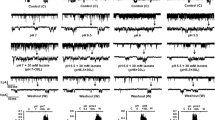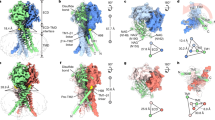Abstract
Voltage-gated proton (H+) channels play a pivotal role in compensating charge and pH imbalances during respiratory bursts in phagocytes. Lactic acidosis is a clinically important metabolic condition accompanying various tissue disorders in which the extracellular pH and the intracellular pH often change in parallel. In this study, we investigated the responses of the H+ channel in microglia to lactate-induced pH disturbances using the perforated-patch recordings. Na-lactate (pH 6.8) acidified the cells and activated the H+ channel within 5 min. This early activation was correlated with increases in the pH gradient across the plasma membrane (ΔpH) and was dose-dependent over a concentration range of 10–150 mM. At 10 mM, the change in ΔpH was only slight, but the H+ currents continued to increase over an hour after the cell acidosis was stabilized. Prolonged exposure to lactate (10–20 mM, >1 h) increased the amplitude by two to threefold. The late activation was not explained by increased ΔpH but by changes in the property of the channel per se. Pretreatment with staurosporine and chelerythrine, inhibitors for protein kinase C, prevented the late activation. These results suggest that the H+ channel could be activated greatly during long-lasting lactic acidosis through both ΔpH-dependent and -independent mechanisms.







Similar content being viewed by others
References
Byerly L, Meech R, Moody W (1984) Rapidly activating hydrogen ion currents in perfused neurones of the snail, Lymnaea stagnalis. J Phyisol 351:199–216
Cohen RD, Woods HF (1983) Lactic acidosis revisited. Diabetes 32:181–191
DeCoursey TE (2002) Voltage-gated proton channels and other proton transfer pathways. Physiol Rev 83:475–579
DeCoursey TE, Cherny VV, Zhou W, Thomas LL (2000) Simultaneous activation of NADPH oxidase-related proton and electron currents in human neutrophils. Proc Natl Acad Sci USA 97:6885–6889
Demaurex N, Petheö GL (2005) Electron and proton transport by NADPH oxidases. Philos Trans R Soc B 360:2315–2325
Eder C, DeCoursey TE (2001) Voltage-gated proton channels in microglia. Prog Neurobiol 64:277–305
Eder C, Fischer HG, Hadding U, Heinemann U (1995) Properties of voltage-gated currents of microglia developed using macrophage colony-stimulating factor. Pflügers Arch 430:526–533
Faff L, Nolte C (2000) Extracellular acidification decreases the basal motility of cultured mouse microglia via the rearrangement of the actin cytoskeleton. Brain Res 853:22–31
Grinstein S, Furuya W (1988) Assessment of Na+–H+ exchange activity in phagosomal membranes of human neutrophils. Am J Physiol 254:C272–C285
Grinstein S, Goetz JD, Furuya W, Rothstein A, Gelfand EW (1984) Amiloride-sensitive Na+–H+ exchange in platelets and leukocytes: detection by electronic cell sizing. Am J Physiol 247:C293–C298
Gordienko DV, Tare M, Parveen S, Fenech CJ, Robinson C, Bolton TB (1996) Voltage-activated proton current in eosinophils from human blood. J Physiol (Lond) 496:299–316
Henderson LM, Chappell JB, Jones OT (1987) The superoxide-generating NADPH oxidase of human neutrophils is electrogenic and associated with an H+ channel. Biochem J 246:325–329
Hoffmann EK, Simonsen LO (1989) Membrane mechanisms in volume and pH regulation. Physiol Rev 69:315–382
Immke DC, McCleskey EW (2001) Lactate enhances the acid-sensing Na+ channel on ischemia-sensing neurons. Nat Neurosci 4:869–870
Kaila K, Ransom BR (1988) Concept of pH and its importance in neurobiology. In: Kaila K, Ransom BR (eds) pH and brain function. Wiley-Liss, New York, pp 3–10
Katsura K, Kurihara J, Siesjo BK, Wieloch T (1999) Acidosis enhances translocation of protein kinase C but not Ca2+/calmodulin-dependent kinase II to cell membrane during complete cerebral ischemia. Brain Res 849:119–127
Kreisberg RA (1984) Pathogenesis and management of lactic acidosis. Annu Rev Med 35:181–193
Kuno M, Kawawaki J, Nakamura F (1997) A highly temperature-sensitive proton current in mouse bone marrow-derived mast cells. J Gen Physiol 109:731–740
Lubec B, Dell’Anna E, Fang-Kircher S, Marx M, Herrena-Marschitz M, Lubec G (1997) Decrease of brain kinase C, protein kinase A, and cyclin-dependent kinase correlating with pH precedes neuronal death in neonatal asphyxia. J Invest Med 45:274–294
Mori H, Sakai H, Morihata H, Kawawaki J, Amano H, Yamano T, Kuno M (2003) Regulatory mechanisms and physiological relevance of a voltage-gated H+ channel in murine osteoclasts: phorbol myristate acetate induced cell acidosis and the channel activation. J Bone Miner Res 18:2069–2076
Morihata H, Kawawaki J, Sakai H, Sawada M, Tsutada T, Kuno M (2000) Temporal fluctuation of voltage-gated proton currents in rat spinal microglia via pH-dependent and -independent mechanisms. Neurosci Res 38:265–271
Morihata H, Nakamura F, Tsutada T, Kuno M (2000) Potentiation of a voltage-gated proton current in acidosis-induced swelling of rat microglia. J Neurosci 20:7220–7227
Murphy R, DeCoursey TE (2006) Charge compensation during the phagocyte respiratory burst. Biochim Biophys Acta 1757:996–1011
Nanda A, Grinstein S (1991) Protein kinase C activates a H+ (equivalent) conductance in the plasma membrane of human neutrophils. Proc Natl Acad Sci USA 88:10816–10820
Rehncrona S (1985) Brain acidosis. Ann Emerg Med 14:770–776
Ringel F, Chang RC, Staub F, Baethmann A, Plesnila N (2000) Contribution of anion transporters to the acidosis-induced swelling and intracellular acidification of glial cells. J Neurochem 75:125–132
Rohra DK, Yamakuni T, Ito S, Saito S, Ohizumi Y (2004) Evidence for the involvement of protein kinase C in acidic pH-induced contraction in spontaneously hypertensive rat aorta. Pharmacology 71:10–16
Salimi K, Moser K, Zassler B, Reindl M, Embacher N, Schermer C, Weis C, Marksteiner J, Sawada M, Humpel C (2002) Glial cell line-derived neurotrophic factor enhances survival of GM-CSF dependent rat GMIR1-microglial cells. Neurosci Res 43:221–229
Siesjö BK (1988) Acidosis and ischemic brain damage. Neurochem Pathol 9:31–88
Siesjö BK, Bendek G, Koide T, Westerberg E, Wieloch T (1985) Influence of acidosis on lipid peroxidation in brain tissues in vitro. J Cereb Blood Flow Metab 5:253–258
Simchowitz L (1985) Intracellular pH modulates the generation of superoxide radicals by human neutrophils. J Clin Invest 76:1079–1089
Staub F, Beathmann A, Peters J, Weigt H, Kempski O (1990) Effects of lactoacidosis on glial cell volume and viability. J Cereb Blood Flow Metab 10:866–876
Thomas RC, Meech RW (1982) Hydrogen ion currents and intracellular pH in depolarized voltage-clamped snail neurons. Nature 299:826–828
Acknowledgements
We would like to thank Dr. Charles Edwards for critically reading the manuscript, Y. Moriura and K. Hiraoka for technical assistance, and Y. Yoshioka and M. Okamoto for secretary assistance. This work was supported by a Grant-in-Aid for Scientific Research from The Ministry of Education, Science, and Culture, Japan.
Author information
Authors and Affiliations
Corresponding author
Rights and permissions
About this article
Cite this article
Morihata, H., Kawawaki, J., Okina, M. et al. Early and late activation of the voltage-gated proton channel during lactic acidosis through pH-dependent and -independent mechanisms. Pflugers Arch - Eur J Physiol 455, 829–838 (2008). https://doi.org/10.1007/s00424-007-0339-7
Received:
Accepted:
Published:
Issue Date:
DOI: https://doi.org/10.1007/s00424-007-0339-7




